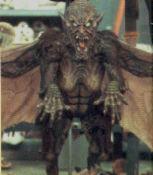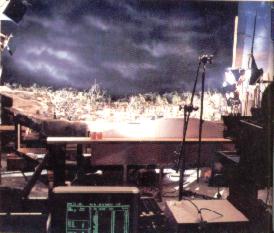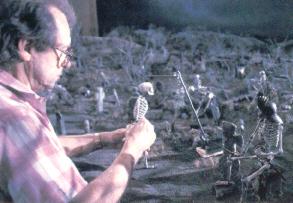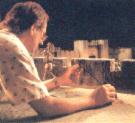
Special F/X
We will deal with this in four sections - select a section from the menu below:
At the end of each section (scroll up/down if necessary) there is a 'Return to top' option
![]()
KNB
E/fx
KNB were delighted to work with
Raimi again and were fooled into thinking that the budget was collossal,
"The script was huge," said Rob Kurtzman the K in KNB. "We didn't know how much money the guys had, and we made a bid
that was four times what we ended up getting."
In order to deal with the films various make-up effects Raimi called upon KNB E/fx, Tony Gardner's Alterian Studios. KNB were responsible for the skeletal effects this included;
![]() Ten mechanical
skeletons: two cable-operated, eight rod-puppeted
Ten mechanical
skeletons: two cable-operated, eight rod-puppeted
Some of these puppets were operated on dolly tracks or
worn as 'back-packs' by crew members walking in trenches. "The thing that Sam tried to do," explained Greg Nictotero, the N in KNB, "because we obviously could only make a limited number of puppets
and suits, was mix them up in every shot." Nicotero continued, "It
gives the impression that there is indeed an army when there were only ten
puppets and 30 close-up suits."
![]() Skeletal body
suits for the numerous extras
Skeletal body
suits for the numerous extras
There were
four groups of body suits designed to cope with close-up and long range shots of
the invading army of the dead:
| Group A: | Sculpted foam-latex bodysuits and heads for close-ups |
| Group B: | Black spandex unitards with skeleton bones constructed onto the suits, and skull masks |
| Group C: | Black spandex suits with skeletal bones painted on |
| Group D: | A set of cloaks and wardrobes |
![]() Breakable Deadite
figures (nicknamed 'Crushites')
Breakable Deadite
figures (nicknamed 'Crushites')
Used in the
'Deathcoaster' scene during the films climax.
![]() The Deadite pit
monsters
The Deadite pit
monsters
Designed by Robert Kurtzman and Howard
Berger.
![]() Full-size Winged
Deadite
Full-size Winged
Deadite
Two versions were built to accomodate
Raimi's initial idea for the 'Sheila Kidnap scene', a mechanical puppet and a
full body suit.

|
 |
| The Winged Deadite Puppet | The Full Body Suit |
"Sam wanted something that could fly in on a crane and interact with the actors", said Nicotero. "We designed it so the actress could put her arms in the wings and flap them, and we attached fake arms upfront." Shooting subsequently fell behind schedule and had to be filmed using the Introvision process utilising plates shot on location.
The puppet was abandoned and the suit was limited to medium shots filmed with interaction between the actress and Embeth Davidtz. In post -production the scene was suplimented with stop-motion animation shots of both the creature and Davidtz.
![]() A witch, inc.
full transformation effects for the deleted 'Temple of Ruins'
scene
A witch, inc.
full transformation effects for the deleted 'Temple of Ruins'
scene
This effect was never utilised although
the original design for the witch was used in an adapted scene where Ash
realises he needs the Necronomicon to get back home. The witch was played by
actress and former stuntwoman Pat Tallman. The 'Temple of ruins' scene will be
discussed later on in this section.
![]() Deadite horses
(not used)
Deadite horses
(not used)
One of the ideas that had to be
scrapped due to budgetary restrictions.
Raimi wanted fullt developed mechanical horses which would have proved costly anyway. KNB developed a cost-cutting alternative that would have proven effective had these scenes been filmed in a controlled evironment such as a studio. "We foam-fabricated an entire skeleton suit on a horse," explained Rob Kurtzman. "It looked really neat, but you needed to shoot it like an optical, against a black background."
Raimi reverted to using real horses which gave him a real headache. See comments above in the 'Notes' section.
![]()
Alterian
Studios
Tony Gardner's Alterian
Studios were called on to supplement the make-up effects works done by KNB and
take care of the areas that KNB couldn't deal with. Therefore, Alterian dealt
mainly with the make-up effects for Ash/Badash and Sheila/Badsheila.
"Splitting it up [the make-up work between KNB and Alterian] added a friendly competition, which was good for us and prevented them from burning out on the workload." mused Bruce Campbell.
![]() Little
Ashes
Little
Ashes
Gardner's most elaborate task was creating
a legion of miniature Ashes that would come out of the shattered pieces of a
mirror and attack the full size Ash. "When they called and told me that the script had tons of little
Bruces running around, I was terrified - I thought it would be 'Army of
Puppets', with a bunch of operators below the set."
recalled Gardner.
During filming the following ocurred:
During this sequence Campbell is tortured by the mini versions of himself which led to some interesting problems for Tony Gardner and his crew. Gardner expains what was needed for the scene where the little terrorist had to hold Campbell's nose and ofrce his mouth open:
"We took a dummy cast of Bruce, put it on a table, and worked out with some posable figures, for example, how these little people would be standing next to his head when they're holding his nose closed and forcing him to open his mouth. We were able to sculpt a body of a specific size whose hands would be at nose level for the shot. We actually pinched Bruce's nose shut, glued the hands to it and glued the puppets' feet to the floor. When Bruce moves around, it looks like they're holding his nose, but he's actually puppeteering them."
![]() Evil
Ash
Evil
Ash
Alterian Studios were also
responsible for the 'birth' sequence of the Evil Ash character.
Originally Raimi wanted to show a moving buldge beneath Campbell's skin
that would move toward his neck; the effect was built but had to be scrapped due
to time limitations.
The Evil Ash Birth sequence;
Evil Ash Make-up and Design
 |
Gardner used the
previous sequence to blast the Evil Ash's facial skin off with a shotgun
blast to make the grotesque decomposition of the character more
beliveable, "I used the gunshot as
an excuse to blow away his skin, to sell the idea beforehand of his
jawbone sticking out, so that when he comes up later, even more rotted
away, it wouldn't be a huge leap."
After Ash hacks up and buries his evil self he inadvertently resurrects him and the rest of the Army of the Dead when he mis-speaks the magic words while taking the Necronomicon from the graveyard. "The idea was that his [Evil Ash's] body didn't fit back together quite right," explained Gardner. "We tried to make it look surreal." |
Alterian were thus responsible for the following:
Gardner had this to say of Campbell, "He's really patient. He had some days when he had to be in the make-up chair all night and they'd shoot his first shot at five a.m. It's night - it's cold - and you've a sponge glued to your head. I don't think people give him the credit he deserves."
![]() Evil Sheila
Make-up and design
Evil Sheila
Make-up and design
Sculpted by
Roger Barelli and applied by Garret Immel. Gardner still designed the look of
the evil version of Sheila. "We tried to
make her look sexy and dead - quite a combination." Gardner opted to move away from the traditional Evil Dead look
and adopt a 'Bride of Frankenstein ' appearance. "We teased her hair out as far as we could, because you first see
her on horseback, and I wanted all this hair flying behind her, with an Elsa
Lancaster look - very pale face, prominent bones."
![]()
Introvision
Studios
This was the
first large scale production that the Introvision process had been used for. It
had been used in the past for OUTLAND, the Chuck Norris flick MEGAFORCE and the
train scene in STAND BY ME to name three.
Introvision was used as a complete production facility by Raimi when budgetary restrictions meant that some location filming couldn't be done.
![]() What is the Introvision
process?
What is the Introvision
process?
It's a dual screen front-projection
process. This allows the actors to be interact with previously shot footage on a
conditioned and controlled soundstage. This process is similar to the old 'Blue
Screen' process but allows the blended scenes to be viewed instantaneously
rather than having to be sent away and processed over a period of weeks (a
process used for Evil Dead 2). Bruce Campbell explains, "...with the
Introvision system , the next day at dailies you see whether it [the sequence]
works or not. Otherwise, we'd be mixing sound effects to numbers. A month after
shooting you're still not sure if a blue-screen shot is going to work - you have
to send it back and have them recomposite, and nothing's free. With Introvision,
basically you look through the camera on stage and say, 'Yeah, that's
right.'"
This formula allows the blended action to look more realistic and less faultless than before, as Introvision effects supervisor Bill Mesa explains, "When we do these shots with live action, the projected plate has a matched move to the Introvision motion-controlled camera. So you get no matte bleeds or any sense of matting something together."
Raimi directed most of the action sequences against background projected plates, such as the final battle sequence, the graveyard or the Little Ashes sequence. Although the process requires careful precision to align both the screens and their mattes and countermattes the pace of shooting wasn't hindered.
![]() The
Set-up
The
Set-up
Introvision had
four stages, including a smaller one for details such as close-ups. While one
setup was being photographed on a particular stage, another could be prepared on
a second stage and the third could be used for an actual set. "We could keep rotating," said Sam
Raimi. "Sometimes, we could knock off four Introvision shots a day,
plus a full day of normal set shooting, so there was really no waiting around.
And you get it back the next day with your dailies, already
composited."
![]()
Introvision's Contributions
Little Ashes
Good Ash vs. Bad Ash
For the sequence where Ash has to walk around his Evil Twin, a scene deleted from the original US release, Campbell is seen to rotate around himself. The following process was adopted to film the scene:
The Graveyard
This was one of the most complicated and extensive
series of shot that were filmed. Introvision provided a full miniature set-up
including skeletons that would be animated either by hand or computer.
Introvision built a forced-perspective
mini-set, blending FOUR different scales to the horizon with the largest 14-inch
skeletons in the foreground; the set was 30ft x
40ft.
 |
| The Graveyard Set |
The phrase coined was 'Go-Animation', a reversal of the traditional stop-motion process whereby the miniture action was shot first and combined with the live action footage later.
Incantations: for the scene where Ash mis-reads the magical words and raises the army of the dead, gravestones are seen to fly like bullets from the ground. The entire graveyard was a miniature set, the tombstones were rigged with air hoses and shot from the ground at a particular cue. Timing was esstential since the air jets, lightning, flying debris and dust were all controlled manually without the use of motion control.
Dead Men Rising: for the scene where Evil Ash supervises the rising of his skeletal army, background plates of animation were shot showing various skeletons digging, walking or rising. Supervising the animation was Peter Kleinow (Robocop, Terminator 2).
 |
| Peter Kleinow animates the skeletons |
As many as 50 moving skeletons were seen in the shot where the camera booms over a hill to reveal the army as the Evil Ash forces himself onto an unwilling Sheila:
The shot last ten seconds in the movie but took 3 days to set-up, rig and light, and around two-and-a-half days to animate. The animators were able to reach the models by the use of 'trenches' cut in the set.
The final sword battles: these were achieved with first filming Bruce Campbell in VistaVision, offering double the negative size of the standard 35mm film, fighting nothing but air. The miniature skeletons were animated based on the choreographed fight sequences and added using the front-projection system. Sparks from the clashing of swords were achieved by attaching an interactive lightning flash on the puppet.
 |
| Kleinow animates the skeletal Evil Ash |
Storming the castle: for the scene where the animated skeletons interact with the live actors ramming down the castle door and then storming it. "Intermixed with those we wanted to add four or five skeletons running in with swords, " explained Introvision Effects Supervisor Bill Mesa. "We photographed a plate on location with [KNB's] Deadites running in. Then on stage, using our tiny Introvision system, because we were just photographing puppets and a piece of castle, we could put the stop-motion characters on the same bridge."
![]()
Production
Design
Introvison turned to
conceptual artist Tony Trembley for the overall look of the film. Trembley was
responsible for designing 20 major sets over an eight month period beginning
January 1991. His work included;
The film's most important set was the castle where most of the films action takes place. The exterior sets only made up 20% of the castle needed to house the action. "Only the lower courtyard, which had to accomodate the Deathcoaster, and certain architectual bits - like the gatehouse, the pit and the blacksmith shop - were full size,." explained Trembley.
![]()
The Scene that got away: The Temple Of Ruins
Click here to read the original script for this scene.
This was intended to be the transition scene in the films where Ash is convinced to journey for the book out of a sense of duty and not just selfishness. Ash would meet and be taught by an Old Witch, played by Patricia Tallman.
 |
| The Set-up for the Temple of Ruins scene |
The miniature effects were shot but the live-action wasn't and the scene was replaced with the confrontaion between Ash and the Witch inside the castle. The witch was still played by Patricia Tallman but her charcter became more sinister. The Temple pillars were supposed to topple, domino style while Ash barely escapes with his life.
| Main index |
| Back to AOD Menu |